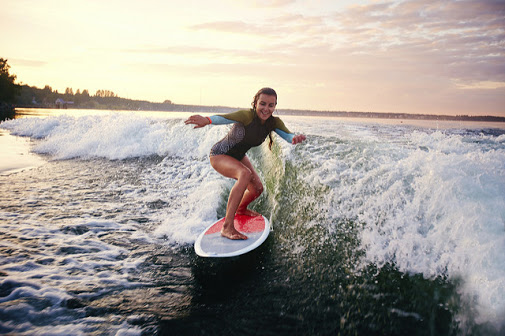The reasons of why take a surf lesson are many. The main reasons are it is more difficult than it looks and when you learn the right techniques and habits from the beginning, you can progress fast.

I frequently get new students who have tried to learn surfing on their own or had a surf lesson in Hawaii and want to take another lesson. Frequently we have to unlearn their new instincts which slows the learning process.
Learn the Precision
Surfing is very precise. The surfboard is designed so the surfer weight is always equal on either side of the stringer down the middle. If weight is pressured on a rail, then the board is designed to carve. If it is not placed correctly, the board flips.
The beginning fundamental is to roll over on the surfboard to catch a foam wave to the beach. Feet have to be in back, nose in the middle, and the board is balanced with the butt. The first two obstacles to catching a wave are the board pearls (nose under water) or the board gets to an angle to the incoming wave and it flips. Both are frequent with beginners.
Don’t Pearl
The secret of not pearling is keeping the feet at the tail of the board, lifting the chest while paddling, and paddling hard for 3 paddles AFTER the foam wave hits the board. The nose starts down when the wave arrives and the surfer paddles until the nose rises in front of the wave.
The secret to preventing the board from flipping from the wave is to paddle hard for 3 to 4 strokes with short paddles to control the direction of the board. Secondly, the surfer should roll over on the board 15 before the wave arrives and start paddling easy. The surfer looks back and when the wave is close, starts paddling hard. The board is not a boogie board and you can’t jump on as the wave arrives.
Learning the Pop UP
The pop up has to be smooth and keep weight centered at all times. I have students count out loud to the sequence and perform it as said. The count is paddle, place hands on the board, push up, put a back foot on the board, stand up, place the front foot on the board.
The finishing posture from the pop up is important. The front foot has to be near the nose of the board. The stance has to be feet shoulder width apart (3′). The hips and shoulders have to be squared to the front (different from how snowboarders ride with one shoulder back). The hands have to be out in front where they can be seen and not have a hand trailing behind.
If the posture is correct after landing a pop up, the surfer will ride straight to the beach with little extra effort. After this is mastered, they can paddle out to catch bigger waves and learn how to carve.
For Oceanside Surf Lessons, see the Home Page
For my Dry Land and in Water Demo video
For Life Style Coaching, Personal Training, and my Book see 9Climb.com